Florina
Florina (Greek: Φλώρινα, Flórina; known also by some alternative names) is a town and municipality in the mountainous northwestern Macedonia, Greece. Its motto is, 'Where Greece begins'.[2]
Florina
Φλώρινα | |
|---|---|
 View of the city of Florina towards the NE | |
 Seal | |
 Florina Location within the region 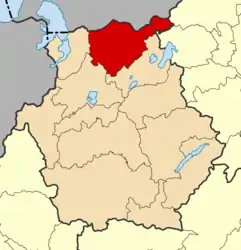 | |
| Coordinates: 40°47′N 21°24′E | |
| Country | Greece |
| Administrative region | Western Macedonia |
| Regional unit | Florina |
| Government | |
| • Mayor | Ioannis Voskopoulos |
| Area | |
| • Municipality | 819.7 km2 (316.5 sq mi) |
| • Municipal unit | 150.6 km2 (58.1 sq mi) |
| Elevation | 687 m (2,254 ft) |
| Population (2011)[1] | |
| • Municipality | 32,881 |
| • Municipality density | 40/km2 (100/sq mi) |
| • Municipal unit | 19,985 |
| • Municipal unit density | 130/km2 (340/sq mi) |
| Community | |
| • Population | 17,907 (2011) |
| Time zone | UTC+2 (EET) |
| • Summer (DST) | UTC+3 (EEST) |
| Postal code | 531 00 |
| Area code(s) | 23850 |
| Vehicle registration | ΡΑ* |
| Website | http://www.cityoflorina.gr |
The town of Florina is the capital of the Florina regional unit and also the seat of the eponymous municipality. It belongs to the administrative region of Western Macedonia. The town's population is 17,686 people (2011 census). It is in a wooded valley about 13 km (8 mi) south of the international border of Greece with the Republic of North Macedonia.
Geography
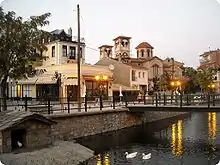
Florina is the gateway to the Prespa Lakes and, until the modernisation of the road system, of the old town of Kastoria. It is located west of Edessa, northwest of Kozani, and northeast of Ioannina and Kastoria cities. Outside the Greek borders it is in proximity to Korçë in Albania and Bitola in North Macedonia. The nearest airports are situated to the east and the south (in Kozani). The mountains of Verno lie to the southwest and Varnous to the northwest.
Winters bring heavy snow and long periods of temperature below freezing point. Furthermore, the town and the surrounding valley is usually covered in thick fog during the winter months that may last even for weeks under specific conditions. During the summer months it becomes a busy market town with an economy boosted by summer and, mostly, winter tourism due to the heavy snowfalls and the nearby ski resorts.
Even though Florina was the site of the first rail line built in the southern Ottoman provinces in the late 19th century, its rail system remains undeveloped. Today, Florina is linked by a single track standard gauge line to Thessaloniki and Bitola, and to Kozani (meter gauge) where it was intended to continue south and link up with the terminal in Kalambaka, in Thessaly but this did not proceed due to the 1930s financial crisis.
Florina is passed by GR-2 (Lake Prespa – Edessa) and GR-3/E65 (Kozani – Florina – Niki – Bitola). The new Motorway 27 (A27) will run east of Florina with its Florina-Niki segment already operational since 2015. The historic Via Egnatia is situated to the east.
Climate
Florina is one of the coldest towns in Greece, because of its elevation and geographic position. Snowfalls, sometimes heavy, thick fog and below-freezing temperatures are common during the winter months, while the summers are warm to hot. Under the Köppen climate classification, Florina has a humid subtropical climate (Cfa), bordering on a humid continental climate (Dfa).
Cold wave of 2012
In the days preceding the early 2012 European cold wave, more specifically on 18 January 2012, a temperature of -25.1 °C was recorded by the HNMS's station[3] with several reports, however, in the local press for temperatures in villages of the municipality that reached -32 °C, but there was no official record of such temperature. The National Observatory of Athens' station reported a temperature of -22.2 °C a day earlier in Florina, while the same station continuously recorded minimum temperatures below -20 °C from 16 January 2012 until 19 January 2012, with the average maximum temperature for January just -0.6 °C, and the prevalence for 13 consecutive days of temperatures below 0 °C 24 hours a day.[4] The above situation resulted in the Greek General Secretariat of Civil Protection to declare the municipality of Florina in a state of emergency on 16 January 2012, at the request of the mayor of Florina, due to the polar temperatures and the intense snowfall that prevailed for days.
| Climate data for Florina (1961–2010) | |||||||||||||
|---|---|---|---|---|---|---|---|---|---|---|---|---|---|
| Month | Jan | Feb | Mar | Apr | May | Jun | Jul | Aug | Sep | Oct | Nov | Dec | Year |
| Record high °C (°F) | 18.0 (64.4) |
23.0 (73.4) |
25.8 (78.4) |
31.2 (88.2) |
33.8 (92.8) |
39.0 (102.2) |
40.8 (105.4) |
38.6 (101.5) |
36.0 (96.8) |
32.2 (90.0) |
26.6 (79.9) |
21.0 (69.8) |
40.8 (105.4) |
| Average high °C (°F) | 4.7 (40.5) |
7.4 (45.3) |
12.0 (53.6) |
16.8 (62.2) |
22.0 (71.6) |
26.4 (79.5) |
29.0 (84.2) |
29.0 (84.2) |
24.7 (76.5) |
19.0 (66.2) |
12.2 (54.0) |
5.9 (42.6) |
17.4 (63.4) |
| Daily mean °C (°F) | 0.6 (33.1) |
2.8 (37.0) |
7.0 (44.6) |
11.7 (53.1) |
16.9 (62.4) |
21.1 (70.0) |
23.4 (74.1) |
22.8 (73.0) |
18.2 (64.8) |
12.9 (55.2) |
7.2 (45.0) |
2.0 (35.6) |
12.2 (54.0) |
| Average low °C (°F) | −3.1 (26.4) |
−1.7 (28.9) |
1.5 (34.7) |
5.4 (41.7) |
9.5 (49.1) |
12.8 (55.0) |
14.8 (58.6) |
14.7 (58.5) |
11.4 (52.5) |
7.1 (44.8) |
2.6 (36.7) |
−1.8 (28.8) |
6.1 (43.0) |
| Record low °C (°F) | −25.1 (−13.2) |
−23.0 (−9.4) |
−13.6 (7.5) |
−5.0 (23.0) |
0.0 (32.0) |
2.4 (36.3) |
6.6 (43.9) |
4.0 (39.2) |
−1.4 (29.5) |
−5.0 (23.0) |
−12.6 (9.3) |
−18.6 (−1.5) |
−25.1 (−13.2) |
| Average precipitation mm (inches) | 56.8 (2.24) |
51.1 (2.01) |
57.8 (2.28) |
60.4 (2.38) |
59.4 (2.34) |
37.3 (1.47) |
33.9 (1.33) |
30.6 (1.20) |
50.1 (1.97) |
69.2 (2.72) |
71.3 (2.81) |
85.6 (3.37) |
663.5 (26.12) |
| Average precipitation days | 11.0 | 10.6 | 11.1 | 10.6 | 10.7 | 7.2 | 5.5 | 5.3 | 6.5 | 7.6 | 9.7 | 11.8 | 107.6 |
| Average snowy days | 7.5 | 6.3 | 4.5 | 0.8 | 0.0 | 0.0 | 0.0 | 0.0 | 0.0 | 0.3 | 1.8 | 5.9 | 27.1 |
| Average relative humidity (%) | 81.2 | 76.4 | 68.8 | 63.2 | 62.8 | 58.6 | 55.4 | 56.9 | 63.3 | 71.4 | 77.8 | 81.7 | 68.1 |
| Source: Hellenic National Meteorological Service [5] | |||||||||||||
Name
The city's original Byzantine name, Χλέρινον (Chlérinon, "full of green vegetation"), derives from the Greek word χλωρός (chlōrós, "fresh" or "green vegetation"). The name was sometimes Latinized as Florinon (from the Latin flora, "vegetation") in the later Byzantine period, and in early Ottoman documents the forms Chlerina and Florina are both used, with the latter becoming standard after the 17th century. The form with [f] (φλωρός) is a local dialect form of χλωρός in Greek. The local Slavic name for the city is Lerin (Лерин), which is a borrowing of the Byzantine Greek name, but with the loss of the initial [x] characteristic of the local dialect. The Albanian name for the city is Follorinë.[6] In Aromanian, it is Florina, while in both Bulgarian and Macedonian, it is Лерин (Lerin).
Municipality
The current municipality of Florina was formed at the 2011 local government reform by the merger of the following 4 former municipalities, that since 2011 became municipal units:[7]
- Florina
- Kato Kleines
- Meliti
- Perasma
The municipality has an area of 819.698 km2, and the municipal unit 150.634 km2.[8]
Municipal Unit subdivisions
The municipal unit of Florina is further divided into the following communities:[7]
- Alona
- Armenochori
- Florina
- Koryfi
- Mesonisi
- Proti
- Skopia
- Trivouno
History
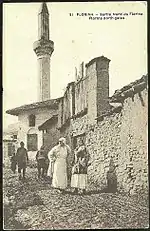

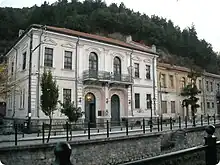
Within the boundaries of the present-day city lie the remains of a Hellenistic settlement on the hill of Agios Panteleimon.[9] Archaeologists excavated on the site in 1930–1934, but a hotel was later built over the ruins. Excavations began again in the 1980s and the total excavated area is now around 8,000 metres square. The buildings uncovered are mostly residential blocks, and the range of finds suggests that the site was continuously inhabited from the 4th century BC until its destruction by fire in the 1st century BC. Many of these finds are now on display in the Archaeological Museum of Florina.
The town is first mentioned in 1334, when the Serbian king Stefan Dušan established a certain Sphrantzes Palaeologus as commander of the fortress of Chlerenon.[10] By 1385, the place had fallen to the Ottomans.[11] An Ottoman defter (cadastral tax census) for the year 1481 records a settlement of 243 households.[12]
Greeks from Florina participated in the Greek Revolution of 1821 with the most important fighter being Aggelinas who also fought in Crete while others also fought in Mesologgi.[13] Members of Filiki Eteria were the brothers Loukas Nedelkos and Nikolaos Nedelkos, who were born in the Florina region.
Florina and its inhabitants greatly contributed to the Macedonian Struggle. Prominent leaders included Nikolaos Pyrzas,[14] and Petros Chatzitasis.[15]
In the late Ottoman period the area surrounding Florina supported the Internal Macedonian Revolutionary Organization (IMRO) who fought against the Ottomans.[16] During the Macedonian Struggle the Greek makedonomachoi gained significant advantage towards the Bulgarian Exarchists within 10 months in 1905 and extended their zone of control in various regions of western Macedonia including the plains north and south of Florina.[17] In 1912 came under the control of the Greek forces as a result of the Ottoman defeat in the First Balkan War. The town was again in the firing line during World War I, during which it was occupied by Bulgaria, and during the Axis Occupation in World War II, when the town became a centre of Slavic separatism.
For part of the Greek Civil War (1946–1949) the mountains of the Florina area were under communist control. The Slavic-Macedonian National Liberation Front, later simply the National Liberation Front or NOF, had a significant presence in the area:[18] by 1946, seven Slav Macedonian partisan units were operating in the Florina area,[19] and NOF had a regional committee based in Florina. When the NOF merged with the Democratic Army of Greece (DSE), many Slav Macedonians in the region enlisted as volunteers in the DSE.[20] When the Communists were defeated on 12 February 1949 by the Greek army thousands of communists and Slav Macedonians were evacuated or fled to Yugoslavia and the Eastern Bloc.
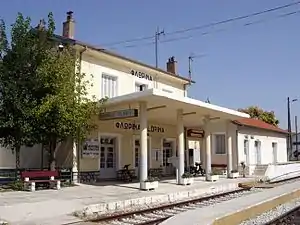
Transport
Rail
The city is served by Florina station on the Thessaloniki–Bitola line, with local trains to Thessaloniki.[21][22]
Economy
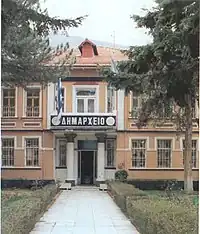
Florina is a market town with an economy dominated by agriculture, forestry, summer and winter tourism, cross-border trading and the sale of local produce such as grain, grapes, and vegetables including Florina peppers. It also has textile mills and is known for locally manufactured leather handicrafts.
The most notable industrial activity is the very large Ptolemaia-Florina lignite mine.
Its university changed in 2002 from being a branch of the Aristotle University of Thessaloniki, to a part of the University of Western Macedonia. After 2004, four departments that previously belonged to the Aristotle University, reinforced its potential.
Florina has 8 radio stations,[23] 2 daily political newspapers, 4 weekly ones, one women's press and two newspapers on sports.
During the 1950s and 1960s, the area lost much of its population to emigration, both to Athens and Thessaloniki as well as US, Canada, Australia and Germany. Following Greece's EU membership and the economic upturn, many from Germany returned.

In 2016 a new Motorway was extended from Florina to the border with North Macedonia.
Landmarks
%252C_Greece.jpg.webp)
- Archaeological Museum of Florina
- Florina Museum of Modern Art
- The Florina Art Gallery
- Folklore Museum of the Aristotle Association
- Folklore Museum of the Culture Club

Demographics
Austrian diplomat Johann Georg von Hahn visited the city in 1861 and wrote about it in his travel log From Belgrade to Salonica. In it he writes that "[a]bout the houses in Florina, we should indicate that there are at most 3000, with half of the population Albanian and Turkish Muslims and the other half Christian Bulgarians."[24] According to an 1878 French ethnographic book Florina was a town of 1500 households, inhabited by 2800 Muslims and 1800 Bulgarians.[25] In 1896 French diplomat and traveller Victor Bérard visited Florina.[26] He described Florina as "consisting of 1500 houses of Albanians and "converted Slavs", with perhaps a hundred "Turkish" families and 500 Christian families."[26] Bérard noted that "These Slavs nonetheless call themselves Greek and speak Greek—with us at least".[26] In 1901/1902 school year statistics, Greek students were clearly much more than the Bulgarian ones.[27]
A Jewish Sephardi community was present in Florina during the 17th century.[28] Under Ottoman rule, the Jews of Florina had close ties with the Jewish community of Monastir (modern Bitola).[29] Romani people migrated from Anatolia to Florina.[30] In the mid to late 1910s, some Florina Romani migrated to Elbasan and Korçë and compose most of their urban modern Romani populations.[30]
According to Tasos Kostopoulos, after Florina became part of Greece, its population numbered 10,000 with two thirds being Muslim.[31] Many Christian inhabitants of Florina were Slavic speakers with the remainder composed of 30 Aromanian families and 89 Greek refugee families from Thrace and Asia Minor.[31] Florina Christians supported the Greek cause and the Bulgarians were aware that more than half were "Grecomans".[31]
Following the Balkan Wars (1912-1913), the large Aromanian community in Monastir (modern Bitola) was disappointed that the city became part of Serbia and they migrated to Greece.[32] Many went to Thessaloniki and others settled in Florina, where in the late 1920s a new neighbourhood was established named Agia Paraskevi with a population of 600 refugee Aromanian families.[33] During the First World War, 60 Jewish families resettled in Florina after they left Monastir in 1916 to avoid the shelling of the city, later some other Monastirli Jewish families also went to live in Florina after the war.[34][29][35]
The Greek census (1920) recorded 12,513 people in the town and in 1923 there were 4,650 inhabitants (or 1076 families) who were Muslim.[36] Muslim Albanians from Florina and the wider region during the Greek-Turkish population exchange (1923) based on religious criteria were sent to Turkey, and mainly resettled in Bursa.[6][37] Following the Greek-Turkish population exchange, in 1926 within Florina there were Greek refugee families from East Thrace (79), Asia Minor (54), Pontus (7) and the Caucasus (44).[36] The Greek census (1928) recorded 10,585 town inhabitants.[36] In 1928, there were 178 refugee families (750 people)[36] and the Jewish community numbered 500 people.[38]
Local Jews were involved in the textile, agricultural and raw material sectors of Florina's economy.[39] Florina was occupied in World War Two and Jews came under German rule.[40] The Jewish community numbered 400 people in 1940.[41] During April 1943, 372 Florina Jews were sent by the Germans first to the Hirsch ghetto in Thessaloniki and later in May sent to the Auschwitz concentration camp where they were gassed.[42][43] In 1945, the Florina Jewish community numbered 64 people, a reduction of 84 percent due to the Holocaust.[44] The Jewish population declined and by 1959 there were 7 Jews in Florina, 1 in 1973 and 0 in 1983.[45]
The Romani of Florina are sedentary and in 1968 they converted from Islam to Orthodoxy.[46] In the modern period, Florina Romani have distanced themselves from their relatives in Elbasan and Korçë, over concerns that links with Muslim Romani could negatively impact their local standing in the area they reside.[46]
During the late twentieth century, Florina numbered some 15,000 inhabitants.[47] Its population was composed of Slavophone Dopii, the Greek Anatolian refugees from the Greek-Turkish population exchange and their descendants, Greeks who had recently left the former Soviet Union, Aromanians and Hellenised Aromanians from Bitola who went to Florina in 1913, Romani, Albanians, and a small number of foreigners.[47]
In fieldwork done by Riki Van Boeschoten in late 1993, the population of Florina is mixed and Greek is often the language used for communication.[48] Minority languages are used in the town, especially on market days when farmers from the villages arrive in Florina to sell their produce.[48] The Romani community of Florina speak Romani and are multilingual in all other languages used in the region.[48]
The Centre for the Macedonian Language in Greece is based in Florina.[49]
| Year | Town | Municipal unit | Municipality |
|---|---|---|---|
| 1981 | 12,573 | - | |
| 1991 | 12,355 | 14,873 | - |
| 2001 | 14,985 | 17,500 | - |
| 2011 | 17,907 | 19,985 | 32,881 |
Florina in cinema
Movies of the Greek cinema, filmed in the area by Theodoros Angelopoulos include:
Notable people

- Alexis Alexoudis (born 1972), footballer
- Mary Coustas (born 1964), Australian actor
- Necati Cumalı (1921-2001), Turkish novelist, short-story writer & poet
- Peter Daicos Australian Football player (AFL); family from Vevi, Florina region
- Dimitris Kalamaras, sculptor
- Dimitrios Makris (1901–81), Member of Parliament & Minister
- Pericles A. Mitkas (born 1962), electronic & computer engineer, Rector of the Aristotle University of Thessaloniki
- Nikolaos Pyrzas (1880-1947), leader during the Macedonian Struggle
- Nadia Tass (active 1979 to present), Australian director & actor
- Vassy (born 1983), Australian singer, songwriter & producer; family possibly of Florina origin
- Pavlos Voskopoulos (born 1964), politician & leader of the Rainbow party
- Elpida Karamandi
Gallery
 French army in the town during WWI
French army in the town during WWI School of Agriculture
School of Agriculture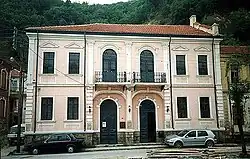
 Grave stele of the Roman period, Archaeological Museum of Florina
Grave stele of the Roman period, Archaeological Museum of Florina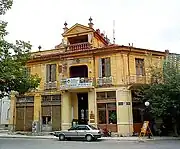
 Main street
Main street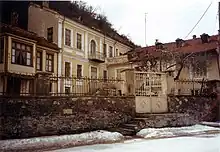 House in Florina. Scenery of Angelopoulos film O Melissokomos
House in Florina. Scenery of Angelopoulos film O Melissokomos A side street leading to the river Sakoulevas
A side street leading to the river Sakoulevas
References
- "Απογραφή Πληθυσμού - Κατοικιών 2011. ΜΟΝΙΜΟΣ Πληθυσμός" (in Greek). Hellenic Statistical Authority.
- Florina official website. Archived 3 June 2006 at the Wayback Machine
- Α.Ε., tovima.gr – Δημοσιογραφικός Οργανισμός Λαμπράκη (6 March 2012). "tovima.gr – Ο πιο βαρύς χειμώνας όλων των εποχών εφέτος". TO BHMA. Retrieved 6 August 2017.
- "NOA's Monthly Weather Report for January 2012" (PDF). Archived from the original (PDF) on 20 January 2013.
- "Mean Florina Climatic Averages". Hellenic National Meteorological Service. Retrieved 11 December 2020.
- Baltsiotis, Lambros (2011). "The Muslim Chams of Northwestern Greece: The grounds for the expulsion of a "non-existent" minority community". European Journal of Turkish Studies. 12.. para. 28-29; footnote 48. "The Albanian claims on the Albanian speaking population of the areas of Kastoria [Kostur in Albanian] and Florina [Follorinë in Albanian] did not ensure the non-inclusion of this Albanian speaking Muslim population in the Greco-Turkish exchange of populations. Nevertheless, these claims and related struggles were far from leading to any major bilateral or international debate."
- "ΦΕΚ B 1292/2010, Kallikratis reform municipalities" (in Greek). Government Gazette.
- "Population & housing census 2001 (incl. area and average elevation)" (PDF) (in Greek). National Statistical Service of Greece. Archived from the original (PDF) on 21 September 2015.
- Maria Akamati-Lilibati & Ioannis M. Akamatis, The Hellenistic City of Florina. Ministry of Culture (Greece), 2006. ISBN 960-86162-3-9 p53ff
- Kravari, p. 247.
- Kravari, p. 55, n. 178.
- Kravari, p. 248.
- Melios, Lazaros (1998). History of Florina (Greek: Από την Ιστορία της Φλώρινας).
- Douglas Dakin, the Macedonian Struggle, 1985, pp 65-67
- Hellenic Army General Staff, Directorate of Army History, The Macedonian Struggle and the events in Thrace, 1979, pp 115
- Gingeras, Ryan (2016). Fall of the Sultanate: The Great War and the End of the Ottoman Empire 1908-1922. Oxford University Press. p. 66. ISBN 9780191663581. "One area where this strategy manifested itself openly was in the environs of Florina, a district notorious for its support for the IMRO."
- Gounaris, Basil C. "National Claims, Conflicts and Developments in Macedonia, 1870-1912" (PDF). macedonian-heritage.gr. p. 194. Retrieved 8 May 2012.
- Simpson, Neil (1994). Macedonia Its Disputed History. Victoria: Aristoc Press, 105,106 & 94. ISBN 0-646-20462-9.
- "Les Archives de la Macedonine, Fond: Aegean Macedonia in NLW" – (Field report of Mihail Keramidzhiev to the Main Command of NOF), 8 July 1945
- Η Τραγική αναμέτρηση, 1945-1949 – Ο μύθος και η αλήθεια. Ζαούσης Αλέξανδρος" (ISBN 9607213432).
- "Visit Florina".
- "Δρομολόγια ΤΡΑΙΝΟΣΕ".
- greek radio guide, radiofono.gr
- Johann Georg von Hahn: [Reise von Belgrad nach Salonik. Viena: 1861, p. 121. https://books.google.bg/books?id=a6JEAQAAMAAJ&pg=RA1-PA120] "Die Häuserzahl von Florina, welches wir wohl auch Flurina, aber niemals Filurina aussprechen hörten, wurde uns gewiss übertrieben auf 3000“) angegeben, deren Bewohner halb aus albanesischen und osmanischen Muhammedanern, halb aus christlichen Bulgaren bestünden."
- „Ethnographie des Vilayets d'Andrinople, de Monastir et de Salonique, Ethnographie Vilayet de Monsati., p.6-21
- Hart, Laurie Kain (2006). "Provincial anthropology, circumlocution, and the copious use of everything." Journal of Modern Greek Studies. 24. (2): 310: "The extreme population movements of the late nineteenth and early twentieth centuries in (what was to become) the western Macedonian border area of Greece expose what Patrick Finney has called the "longue durée quality of nation-formation (Finney 1993). They include not only the 1919 Bulgarian-Greek population exchange and the Greek-Turkish exchange of 1923, but also innumerable significant, informal, earlier shifts to towns such as Florina by Muslim and Christian Albanians, Turks, Vlachs, Gypsies, Jews, as well as the immigration of Greek Christians from the South after the mid-nineteenth century Ottoman Tanzimat reforms." p. 314. "Florina was not much admired by European travelers in the dying days of the Ottoman Empire, particularly, it seems, in contrast to its rival a little to the south, Kastoria. The French traveler Bérard describes it in 1896 as consisting of 1500 houses of Albanians and "converted Slavs", with perhaps a hundred "Turkish" families and 500 Christian families. "These Slavs nonetheless call themselves Greek and speak Greek—with us at least" (Bérard 1911 (1896):307). Bérard identifies only a few hundred Bulgarian sympathizers, but notes that the local Turkish administration is pro-Bulgarian."
- Νεότερη ιστορία της Μακεδονίας 1830-1912, Konstantinos Ap. Vakalopoulos, pub. Αντώνιου Σταμούλη, Thessaloniki, 2000, p. 240
- Stavroulakis, Nicholas; DeVinney, Timothy J. (1992). Jewish sites and Synagogues of Greece. Talos Press. p. 236. ISBN 9789607459015.
- Plaut 2000, p. 26.
- De Soto, Hermine; Beddies, Sabine; Gedeshi, Ilir (2005). Roma and Egyptians in Albania: From social exclusion to social inclusion. World Bank Publications. p. 231. ISBN 9780821361719.
- Karakasidou, Anastasia (2020). "Voters and clients: Elections in Florina before and after the Prespa Accord". In Neofotistos, Vasiliki P. (ed.). Macedonia and Identity Politics After the Prespa Agreement. Routledge. p. 130. ISBN 9781000281835.
- Koukoudis 2003, pp. 466-468.
- Koukoudis, Asterios (2003). The Vlachs: Metropolis and Diaspora. Zitros Publications. pp. 467, 473. ISBN 9789607760869.
- Cohen, Mark (2003). Last Century of a Sephardic Community: The Jews of Monastir, 1839-1943. Foundation for the Advancement of Sephardic Studies and Culture. p. 134. ISBN 9781886857063.
- Mihajlovski, Robert (2021). The Religious and Cultural Landscape of Ottoman Manastır. Brill. p. 232. ISBN 9789004465268.
- Pelagidis, Efstathios (1992). Η αποκατάσταση των προσφύγων στη Δυτική Μακεδονία (1923-1930) [The rehabilitation of refugees in Western Macedonia: 1923-1930] (Ph.D.). Aristotle University of Thessaloniki. p. 75. Retrieved 30 March 2022.
- Gingeras, Ryan (2009). Sorrowful Shores: Violence, Ethnicity, and the End of the Ottoman Empire 1912-1923. Oxford: Oxford University Press. pp. 158–159. ISBN 9780199561520.
- Plaut 2000, p. 69.
- Plaut 2000, p. 43.
- Plaut 2000, p. 56.
- Plaut 2000, p. 68.
- Plaut 2000, p. 60.
- Bowman, Steven B. (2009). The Agony of Greek Jews, 1940–1945. Stanford University Press. pp. 80, 83, 85–86, 91. ISBN 9780804772495.
- Plaut 2000, pp. 68–69, 71.
- Plaut, Joshua Eli (2000). Greek Jewry in the Twentieth Century, 1913-1983: Patterns of Jewish Survival in the Greek Provinces Before and After the Holocaust. Associated University Presses. pp. 20, 69, 96, 98. ISBN 9780838639115.
- Baltsiotis, Lambros (2015). "Balkan Roma immigrants in Greece: An initial approach to the traits of a migration flow". International Journal of Language, Translation and Intercultural Communication. 2: 5. doi:10.12681/ijltic.47.
- Cowan, Jane K. (2003). "The uncertain political limits of cultural claims: Minority rights politics in south east Europe". In Mitchell, Jon P.; Wilson, Richard A. (eds.). Human Rights in Global Perspective: Anthropological Studies of Rights, Claims and Entitlements. Routledge. p. 149. ISBN 9781134409754.
- Van Boeschoten, Riki (2001). "Usage des langues minoritaires dans les départements de Florina et d'Aridea (Macédoine)" [Use of minority languages in the departments of Florina and Aridea (Macedonia)]. Strates. 10. para. 15.
- Stamatoukou, Eleni; Marušić, Siniša Jakov (30 November 2022). "Macedonians Hail Opening of Pioneer Language Centre in Greece". Balkan Insight.
- The Columbia Encyclopedia, 2004
- Encyclopædia Britannica, 2005
- The Penguin Encyclopedia of Places, 1999
- Rough Guide to Greece, Mark Ellingham et al., 2000
Notes
External links
- City of Florina (in Greek)
- Florina regional unit (in Greek)
- Awarded "EDEN – European Destinations of Excellence" non traditional tourist destination 2007


